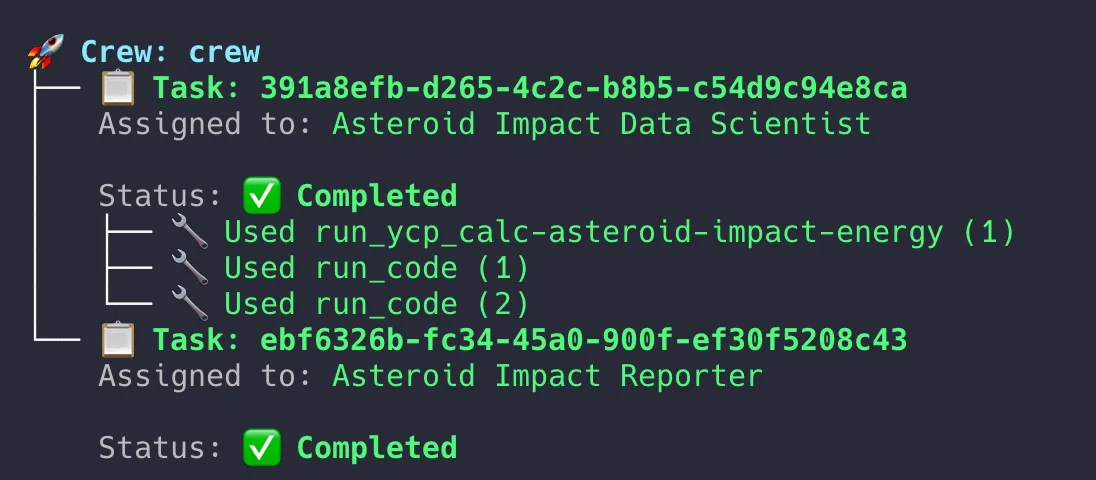Integrating YepCode with crewAI: Build Multi-Agent AI Workflows That Run Real Code

Modern AI agents can do more than just chat—they can reason, collaborate, and even execute real code to solve complex tasks.
What if you could combine multi-agent intelligence with cloud-powered code execution?
In this post, you’ll see how to connect crewAI and YepCode to build a workflow where agents not only think, but act—automating a real-world scenario from start to finish.
Motivation & Use Case
Why multi-agent systems? Because real-world problems are rarely solved by a single expert—they require collaboration, specialization, and the ability to take action.
Imagine automating scientific analysis and reporting, end-to-end, with agents that both think and do.
In this demo, we tackle a scenario with real stakes: assessing the impact of an asteroid hitting Earth. (Okay, it’s a fun and slightly tongue-in-cheek example—but perfect for showing how agents can combine reasoning, data, and automation to deliver results you can use.)

No planets were harmed in the making of this post.
Tech Stack Overview
This project brings together two powerful tools:
- crewAI: Lets you build teams of AI agents that can reason, collaborate, and delegate tasks—just like a real crew.
- YepCode: A cloud platform where agents can run real code, automate workflows, and interact with APIs on the fly.
Together, they let your agents not only think, but act.
Scenario: Asteroid Impact Assessment
Our agents are on a mission: figure out what would happen if an asteroid hit Earth, and write up a dramatic report.
- Asteroid Data Scientist: Crunches the numbers and calculates the impact.
- Impact Reporter: Turns the data into a story that’s fun (and maybe a little scary) to read.
Project Setup
Getting started is easy:
1. Clone the repo and create a virtual environment.
2. Install dependencies with a couple of commands.
3. Copy `.env.example` to `.env` and add your API keys.
You’ll need Python 3.10–3.12, plus a free YepCode and OpenAI account.
Defining Agents and Tasks
Agents and their goals are defined in simple YAML files:
- agents.yaml: Who does what (e.g., Data Scientist, Reporter)
- tasks.yaml: What needs to be done, and in what order
Tweak these files to create your own agent teams and workflows!
Integrating YepCode
For this scenario, we’re using the YepCode MCP server—an ideal fit when agents need to run real code and automate complex tasks.
While CrewAI lets you create custom tools directly in your project, using YepCode MCP is even more powerful:
- You can define, update, and manage your tools in YepCode’s platform.
- Instantly expose new tools to your agents with just a line of code—no redeploy needed.
- Perfect for scientific tasks, data processing, or any workflow where flexibility and cloud execution matter.
In this project, the Asteroid Data Scientist agent uses YepCode MCP to perform calculations. By default, YepCode MCP provides a run_code action that can execute any Python or JavaScript code—so your agent can dynamically generate and run code to solve the problem, not just call a fixed API.
You can also create your own custom tools in YepCode—like a dedicated “Calculate Asteroid Impact Energy” process. (I’ll show how to add and use a custom tool in this post, with the code and setup!)
This flexibility is what makes YepCode MCP a perfect match for agent-based workflows.
Running the Workflow
Just run one command:
You will be prompted with all the crewAI workflow steps in the terminal, showing how agents collaborate to solve the task.

Steps taken by the crew
Once the workflow ends you’ll get a file like asteroid_impact_report.md with the outcome.

Preview of asteroid_impact_report.md file
Conclusion
By combining crewAI and YepCode, you unlock a new level of AI automation—where agents can collaborate, reason, and execute real code to solve real problems.
Try the repo, remix the agents, and imagine what you could automate next!Curious to try this for your own API or use case? Contact us — we’d love to hear what you’re building.